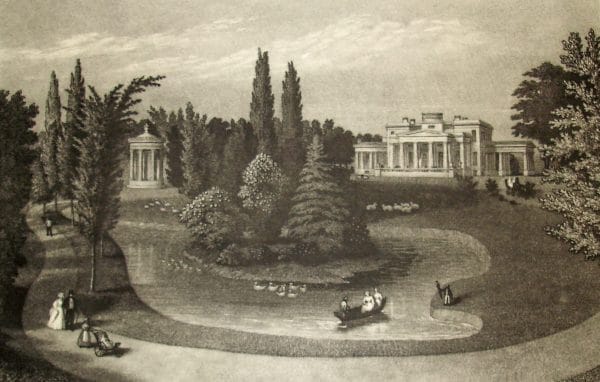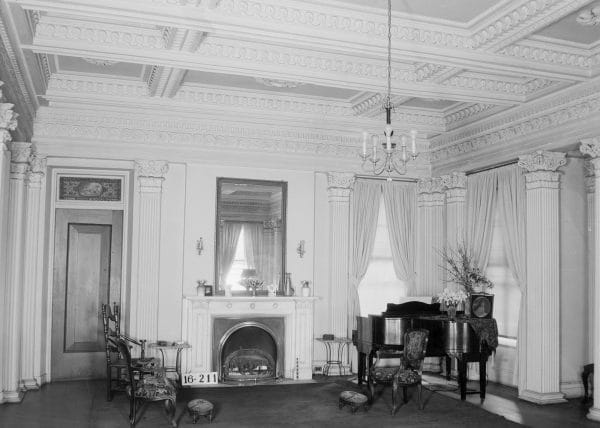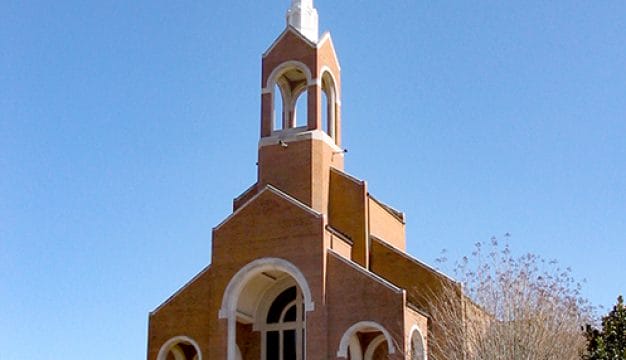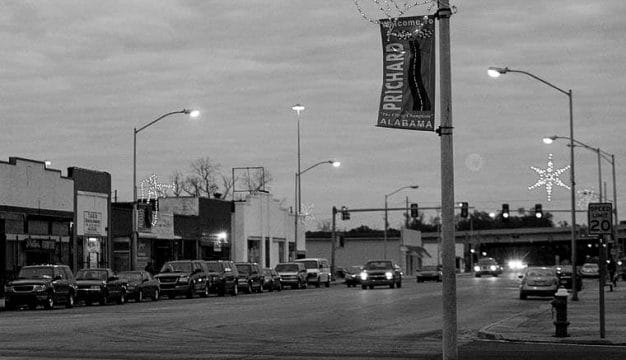Gaineswood National Historic Landmark
 Gaineswood
Gaineswood, a historic house located in Demopolis, Marengo County, is an important example of Greek Revival architecture because it demonstrates the interpretations by Gen. Nathan Bryan Whitfield, an amateur designer, of the prevailing architectural style of his day. Gaineswood exemplifies the Black Belt‘s significance in Alabama‘s economic and cultural history. Once the center of a large plantation, the main house and other surviving structures now lie within the borders of the town of Demopolis. Gaineswood is operated as a museum by the Alabama Historical Commission and was added to the National Register of Historic Places in 1972 and designated as a National Historic Landmark in 1974.
Gaineswood
Gaineswood, a historic house located in Demopolis, Marengo County, is an important example of Greek Revival architecture because it demonstrates the interpretations by Gen. Nathan Bryan Whitfield, an amateur designer, of the prevailing architectural style of his day. Gaineswood exemplifies the Black Belt‘s significance in Alabama‘s economic and cultural history. Once the center of a large plantation, the main house and other surviving structures now lie within the borders of the town of Demopolis. Gaineswood is operated as a museum by the Alabama Historical Commission and was added to the National Register of Historic Places in 1972 and designated as a National Historic Landmark in 1974.
 Nathan Bryan Whitfield
The estate on which Gaineswood sits was first owned and named by territorial legislator and trader George Strother Gaines, who built a cabin on the site in the 1820s. In 1842, Whitfield, a native of Lenoir County, North Carolina, purchased the cabin and 480 acres of land from Gaines. An officer in the North Carolina militia and member of the North Carolina General Assembly, Whitfield was a wealthy planter and owned many slaves. He had first settled his family near the present-day community of Jefferson at a plantation he called Chatham. After losing three children within weeks of each other to yellow fever, he and his wife decided to move to a healthier location outside Demopolis and purchased the property from Gaines. By 1860, Whitfield would own as many as 7,200 acres and 235 slaves and produced nearly 600 bales of cotton that year, though not all at Gaineswood. The two-room cabin quickly proved too small, and Whitfield embarked on a large-scale redesign and expansion of the house. Between 1843 and 1861, Whitfield built and rebuilt his house, employing numerous enslaved and free craftsmen, as well as skilled artisans such as painter, decorator, and stained glass artisan John Gibson and painter John Verdin to construct his designs. Whitfield served as his own architect, taking his ideas from architectural treatises and from his extensive travels in the Northeast. The finished structure, named Gaineswood after the estate’s original owner, reflects Whitfield’s eclectic interests, incorporating elements of Greek Revival architecture, such as a massive front portico and the use of Doric, Corinthian, and Ionic columns.
Nathan Bryan Whitfield
The estate on which Gaineswood sits was first owned and named by territorial legislator and trader George Strother Gaines, who built a cabin on the site in the 1820s. In 1842, Whitfield, a native of Lenoir County, North Carolina, purchased the cabin and 480 acres of land from Gaines. An officer in the North Carolina militia and member of the North Carolina General Assembly, Whitfield was a wealthy planter and owned many slaves. He had first settled his family near the present-day community of Jefferson at a plantation he called Chatham. After losing three children within weeks of each other to yellow fever, he and his wife decided to move to a healthier location outside Demopolis and purchased the property from Gaines. By 1860, Whitfield would own as many as 7,200 acres and 235 slaves and produced nearly 600 bales of cotton that year, though not all at Gaineswood. The two-room cabin quickly proved too small, and Whitfield embarked on a large-scale redesign and expansion of the house. Between 1843 and 1861, Whitfield built and rebuilt his house, employing numerous enslaved and free craftsmen, as well as skilled artisans such as painter, decorator, and stained glass artisan John Gibson and painter John Verdin to construct his designs. Whitfield served as his own architect, taking his ideas from architectural treatises and from his extensive travels in the Northeast. The finished structure, named Gaineswood after the estate’s original owner, reflects Whitfield’s eclectic interests, incorporating elements of Greek Revival architecture, such as a massive front portico and the use of Doric, Corinthian, and Ionic columns.
 Sartain Engraving of Gaineswood
In 1861, Whitfield hired a photographer to record Gaineswood and its English Regency style park-like setting. Philadelphia engraver John Sartain used this photograph to produce a steel engraving that shows Gaineswood as it looked when the Whitfields resided there. The image depicts the house with its massive front portico, artificial lake, ornamental plantings, and gazebo. In addition to the main house, there are several other structures, including a kitchen building, slave quarters, and stables, that remain on site. The pantry and the plantation office are located to the southeast of the main house. The gazebo was moved closer to the house after the lake was filled in, and the gatehouse was reconstructed during the 1970s.
Sartain Engraving of Gaineswood
In 1861, Whitfield hired a photographer to record Gaineswood and its English Regency style park-like setting. Philadelphia engraver John Sartain used this photograph to produce a steel engraving that shows Gaineswood as it looked when the Whitfields resided there. The image depicts the house with its massive front portico, artificial lake, ornamental plantings, and gazebo. In addition to the main house, there are several other structures, including a kitchen building, slave quarters, and stables, that remain on site. The pantry and the plantation office are located to the southeast of the main house. The gazebo was moved closer to the house after the lake was filled in, and the gatehouse was reconstructed during the 1970s.
Whitfield died in 1868, after having sold Gaineswood and the surrounding land to his son Bryan Watkins Whitfield. In 1896, Bryan Whitfield’s sister Edith Whitfield Dustan purchased the property. In 1923, the house passed out of family hands to the Kirven family. Over the next few decades, the house changed hands several times. It was extensively photographed by the Historic American Building Survey in the 1930s. The state acquired Gaineswood in 1967 and transferred it to the Alabama Historical Commission (AHC) in 1971. After extensive restoration, AHC opened Gaineswood to the public in 1975.
 Gaineswood Ballroom
The house today features a number of furnishings owned by the Whitfield family and is decorated in the style of 1861. Among the significant holdings in the collections is the flutina, a barrel organ Whitfield designed; a silver epergne, an ornamental centerpiece for the dining table; a pineapple, symbol of hospitality, that Whitfield carved and which originally graced the roof of the gazebo; and elaborately carved beds that the family brought from North Carolina.
Gaineswood Ballroom
The house today features a number of furnishings owned by the Whitfield family and is decorated in the style of 1861. Among the significant holdings in the collections is the flutina, a barrel organ Whitfield designed; a silver epergne, an ornamental centerpiece for the dining table; a pineapple, symbol of hospitality, that Whitfield carved and which originally graced the roof of the gazebo; and elaborately carved beds that the family brought from North Carolina.
Gaineswood is located at 805 South Cedar Avenue, in Demopolis, and has a staff of three employees and 20 volunteers. Gaineswood attracts approximately 3,000 visitors annually and offers cell phone audio tours. Annual events include Christmas in the Canebrake, held on the first Thursday in December, and Heritage Days, a living-history event for elementary school students held each April.
Further Reading
- Barrett, Kayla. “The Whitfields Move to Alabama: A Case Study in Westward Migration, 1825-1835.” Alabama Review 48 (April 1995): 96-113.
- Marengo County Heritage Book Committee. The Heritage of Marengo County, Alabama. Clanton, Ala.: Heritage Publishing Consultants, 2000.
- Smith, Winston. The People’s City: The Glory and Grief of an Alabama Town 1850-1874. Demopolis, Ala.: Marengo County Historical Society, 2003.


